The zero hour was upon us, the false starts behind us, and our trek across northern Spain to Santiago de Compostela along the medieval Camino Frances was in forward motion. Following the same trend as 93% of Camino pilgrims, our feet were our mode of transportation. The challenge would be to keep them moving – one step at a time, one foot in front of the other, on and on, over and over. Feet, keep trudging.
Remind me why I got myself into this wackadoodle escapade.
As Newbie Pilgrims, Hubs and I had to get up to speed with Camino lingo.
Pilgrims are peregrinos/peregrinas. The term peregrino has been used since the 4th century to refer to “a person who travels to a holy place.”
The stone markers that indicate the distance to Santiago are called mojónes. If you want to dazzle everyone with your brilliance use mojónes. But if you want to be understood, stick to calling them distance markers. Modern markers have yellow arrows or scallop shell symbols pointing in the direction of Santiago, as well as a notation of the remaining number of kilometers.
On the topic of stone markers, we will pass several rock cairns, known in Spanish as milladoiros. Originally, cairns served as directional markers for travelers or as symbols of protection for pilgrims. Today people build them for varied reasons.
Pilgrims greet each other by saying “Buen Camino”. This means “good journey”. This term will remain rooted in your mind forever after you walk the Camino because you say it thousands of times.
Now it’s your turn to give Camino lingo a shot. “Buen Camino peregrino. I missed the mojóne with the milladoiro.”
On second thought, scrap that idea. Just say, “I missed the distance marker with the rock cairn.” You’ll have a better chance of being understood.
Do pilgrims REALLY learn Camino lingo before hitting the road? Not a chance!
The iconic yellow arrows now found on all routes of the Camino de Santiago first started to appear in 1984. Father Elias Valiña, a priest dedicated to studying Camino history, decided to mark the original route of the Camino Frances with yellow arrows to help pilgrims find their way to Santiago de Compostela.
Why yellow paint? El padre received an offer he could not refuse from the Spanish Roadworks Department on their leftover stock of yellow paint.
The industrious priest jumped into his old Citroën, drove alongside the Camino Frances, and marked yellow arrows on trees, rocks, abandoned buildings, and anything else that was stationary. It took the in-depth Camino knowledge of someone like Father Elias Valiña to locate and mark the overwhelming number of sections that were obscure or heavily overgrown.
When asked what he was doing, Valiña’s standard answer was, “Preparing for an invasion.” This response landed him behind bars more than once. Unfortunately, his early death in 1989 prevented him from ever witnessing the multiple invasions of pilgrims who have subsequently followed his yellow arrows along the Camino.
Thanks to the visionary forward thinking of Elias Valiña and his yellow arrows, walking the Camino Frances is less like navigating a maze and more like following a self-guided path through a medieval world.
A wrong turn on the Camino means one thing and one thing only — MORE WALKING to get back on course. After seventy or eighty kilometers, the feet begin the grumble when they are subjected to cruel and unnecessary TORTURE. But, that is fodder for future episodes.
After walking 15 km from our morning starting point at Sarria, we passed the 100 km distance marker around 2 o’clock in the afternoon.
Why so slow? Hills, hills, and more hills.
To qualify for the Pilgrim’s Certificate, a pilgrim is required to provide documented proof of walking the FINAL 100 km of the Camino. We carried our “Pilgrim’s Passports” with us for that purpose and got them stamped at designated sites along the way.
We took a pit stop and ate a late lunch at the hamlet of Ferreiros.
On the road again. Left right, left right, left right…. For the most part, we had the Camino to ourselves. The rush hour traffic of go-getter peregrinos that charged out of Sarria that morning had left us behind in a cloud of dust hours earlier. We were on our own, two lone peregrinos. Just Hubs and me, plodding methodically from one yellow arrow to the next.
Oh no! I have to go POTTY!
How far to the next town? 8 kilometers? Well… I’ll just go off the beaten track a bit and take care of some business. Yup, that looks like a good bush to go behind.
Like a seasoned medieval peregrina, I picked my way between the rocks, bushes, and thorns until I found the perfect place to do my lady business.
My drawers were down around my ankles and my fanny was pointed in the air when I heard something. WHAT’s THAT?? PEOPLE!!
Only then did I notice my secluded spot was NOT so secluded.
Call me a prude if you want, I did not fancy the prospect of mooning the approaching peregrinos as they walked by. For all I knew, we would end up eating at the same table that evening. I could already hear the embarrassing conversation in my mind… “Oh, it’s you! Didn’t you moon us this afternoon? That was YOUR butt, wasn’t it?”
Acting quickly, I bent down and grabbed for my pants, a move that caused my backpack to shift topsy-turvy to the side, and sent my water bottle crashing to the ground — emptying its contents all over my pants.
From my contorted position I stretched my arm out like Gumby-Woman until I managed to grasp the waistband on my water-drenched pants.
With one fluid motion, I Jumped Up, Zipped Up, and…
GIMPED UP my knee.
Bracing myself as best I could, I stood in the foliage, feigning interest in the flowering bush, sporting a goofy grimace, and gritting my teeth while I bid “Buen Camino” to the passing peregrinos.
When the coast was clear I hobbled back onto the Camino. I wondered why I hadn’t just mooned them.
I had 97 kilometers to go and a bunged knee. I had NEVER experienced any problems with my knee before that.
We were among the last of the peregrinos to limp into Portomarin at the end of the day. But what did it matter? The important thing was we made it!
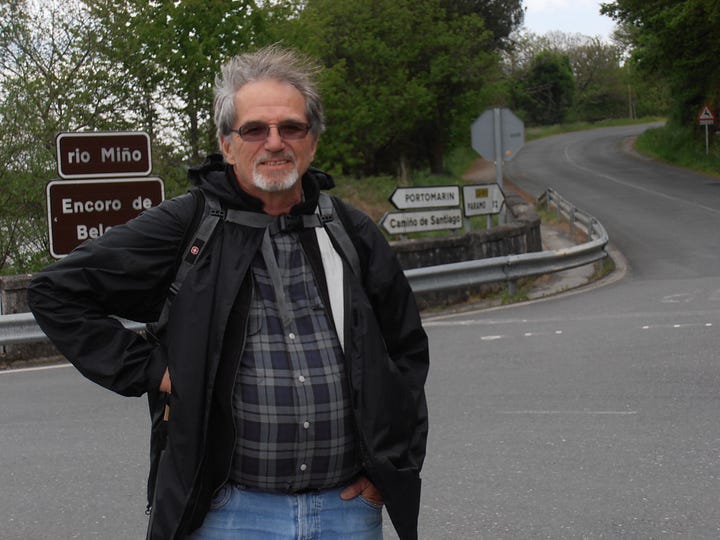
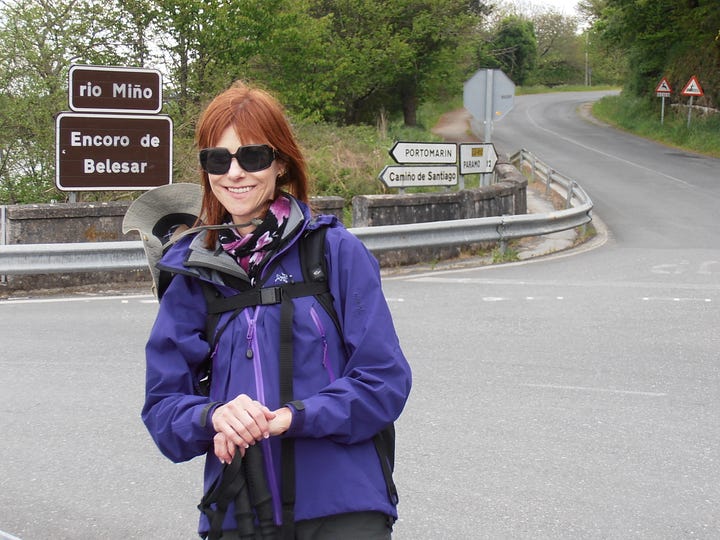
Our first stop in Portomarin was the Farmacia. Hubs, the Boy Scout advised me I needed an Ace bandage for my knee. Fortunately, the Farmacia had exactly what I needed. It helped a lot. It would have been game over for me without it.
Portomarin had a highly unusual history…
The original town of Portomarin was on a hillside along the shores of the Miño River. In the late 1950s, planning began for the construction of a hydroelectric dam on the Miño that would SUBMERGE the entire town of Portomarin under the waters of the new Belesar Reservoir. Tragically, the buildings in the town dated right back to the 9th century.
The townsfolk refused to let Portomarin become PortoSubmarine under their watch!
Stone by stone, building by building, they DISMANTLED the town and MOVED it to higher ground where they REASSEMBLED everything in the EXACT SAME order.
Wow! That wins the prize as the GRANDADDY of ALL Lego Projects!
This feat took six years, from 1956 to 1962 under the watchful eye of Architect Francisco Sorollo. By 1962 remnants of the former town of Portomarin disappeared to the bottom of the reservoir.
That evening in the dining room of our hotel we met a man and his son who were from our home state of Texas. The older gentleman portrayed himself as a Camino expert.
Several newbie peregrinos gathered around Tex to hear what he had to say, and it was a LOT!
Tex had one message he kept driving home like a jackhammer — Push through the pain and don’t give up. Push through the pain and don’t give up.
Got it! Push through the pain and don’t give up.
Hubs and I later found out that Tex had NEVER walked the Camino before.
However, his deceased wife had walked it several times. Tex and Tex Jr. were carrying the dear woman’s ashes over the Camino for one final pilgrimage. Like us, they had completed 21.6 kilometers and their journey had just begun.
Watch for the next episode of El Camino de Santiago as Hubs and I continue our pilgrim journey along the ancient road. Adventure, fun, history and challenges await us on the path ahead.






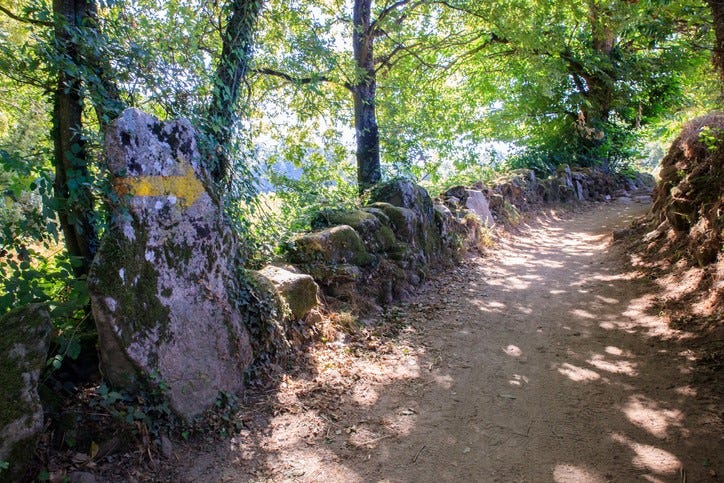


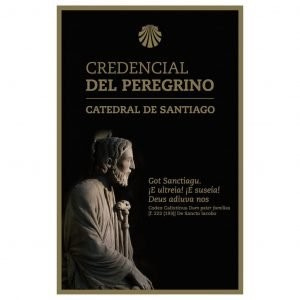

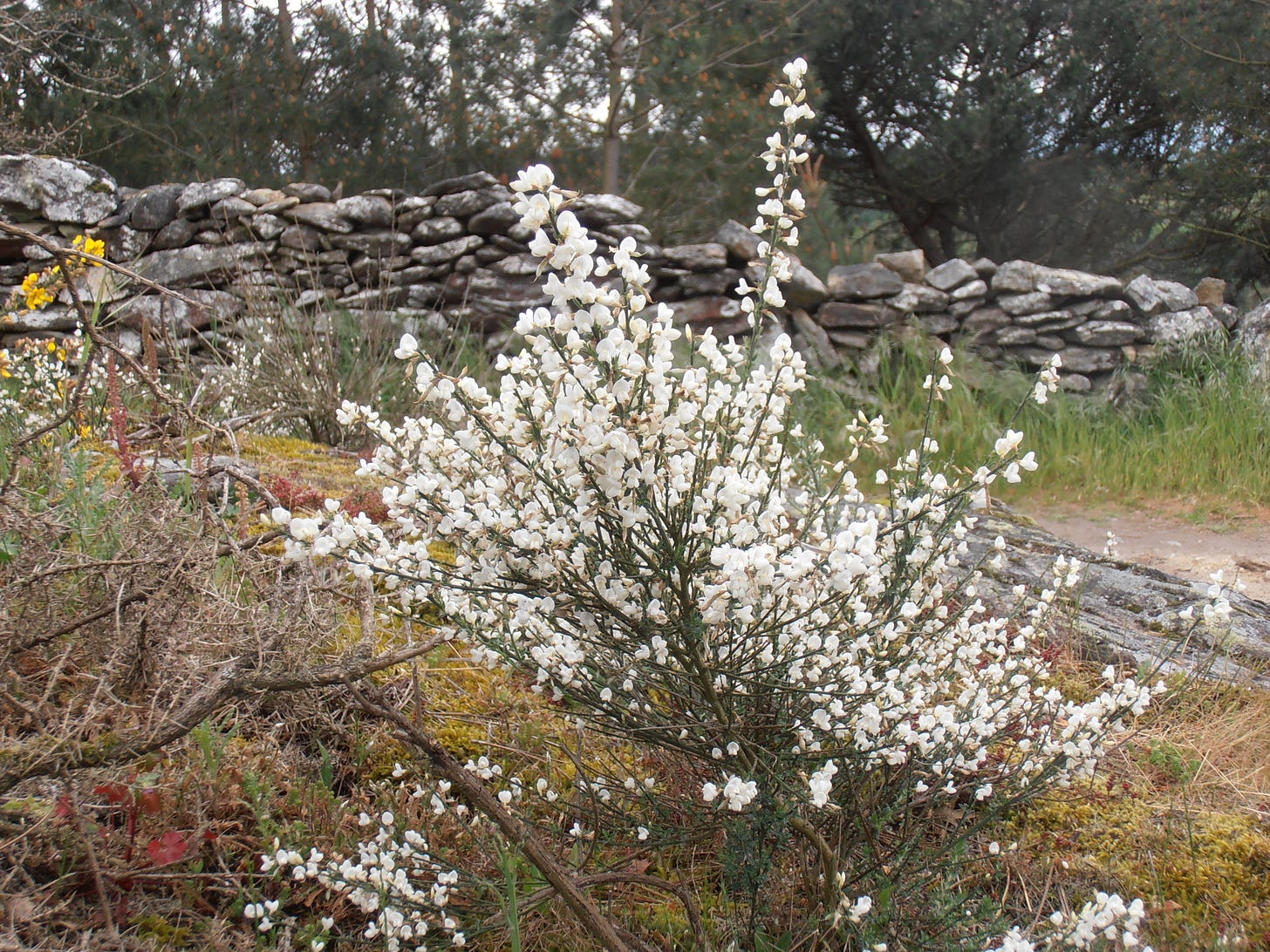
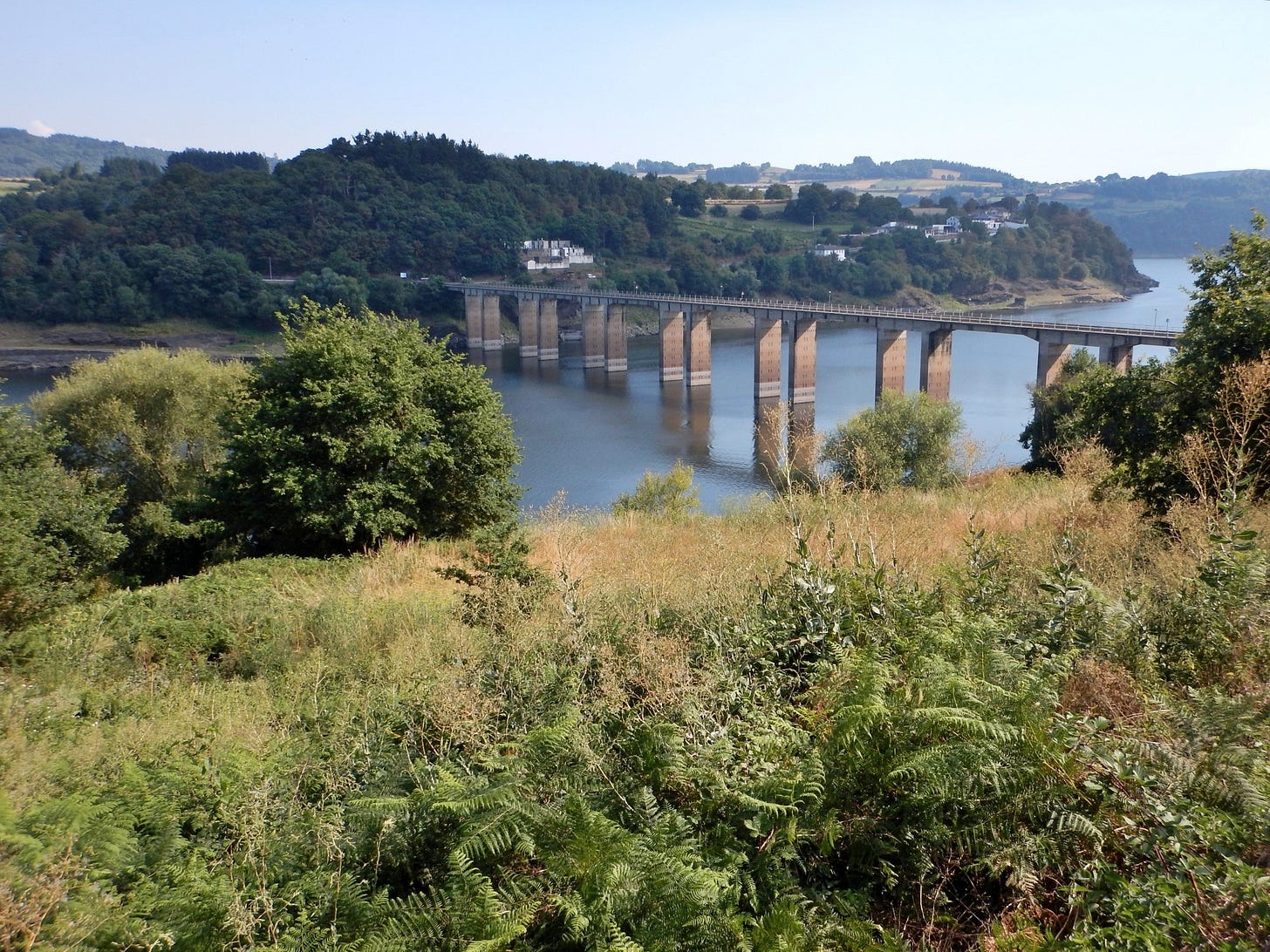
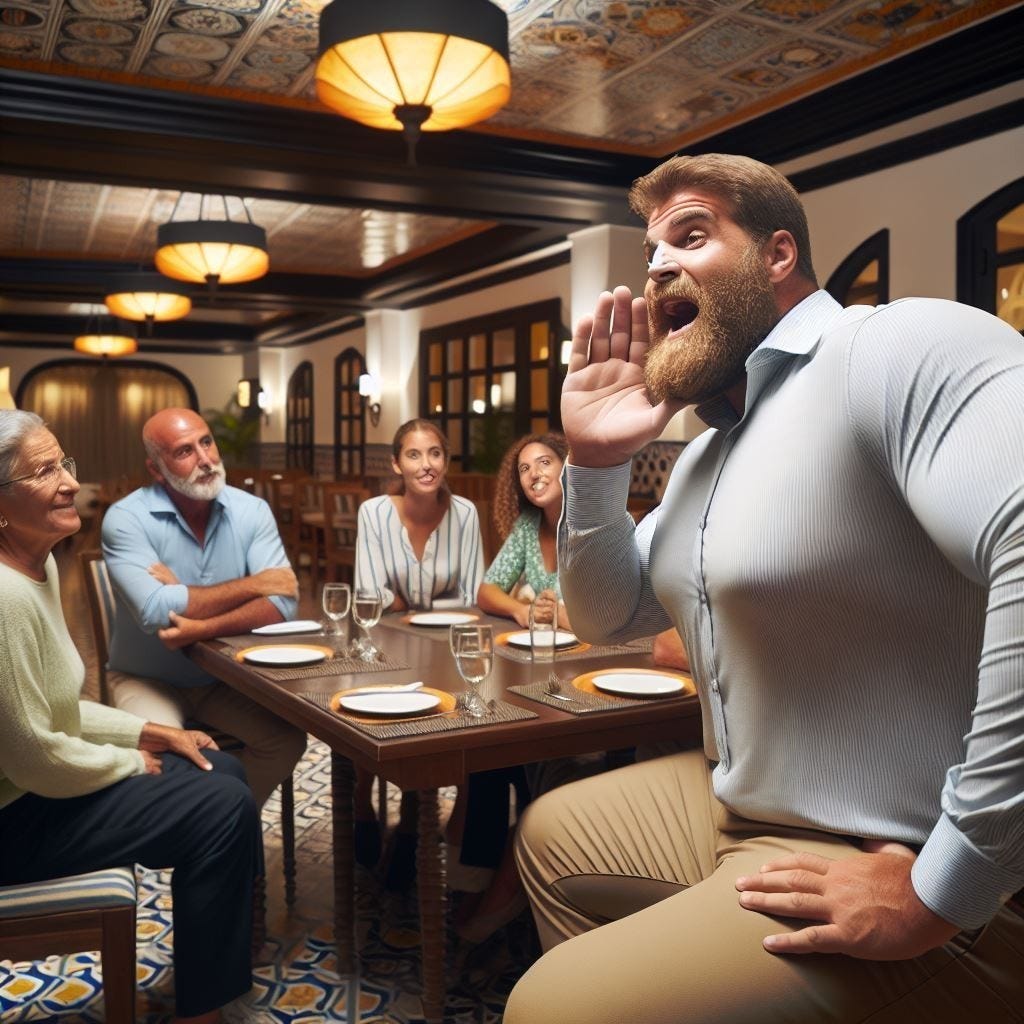

Lois, first of all I'm glad you got the bandage for your knee. I hope it kept everything in place. As always your magnficient retelling of your trip had me wishing that I had made that pilgrimate with you. I also remembered that our junior high school Spanish text was called "Camino Real" which was a beautiful book that I wish I still had. If I ever see it in a used book store, I will snag in It not only taught you the language, but the cultural history of Spain with wonderful illustrations.
I was able to find my Sixth grade reader which was a novel by Newberry award winning author Elizabeth Coatsworth. It is called "Runaway Home" and is illustrated by the great Gutav Tenngrenn who has also illustrated "King Arthur," "The Canterbury Tales," "Grimms Fairy Tales," and designed the look for Disney's original animated "Pinoccho." You brought all this back for me. Thank you.
It's incredible you're doing the journey, Lois. It looks beautiful--and Imagine getting into the walking groove takes a while. Also, love that the town refused to be submerged and moved it, stone by stone. Great story. Buen viaje ! Peligrina! (or is it 'o.' at end as in all pilgrims are masculine in the language).